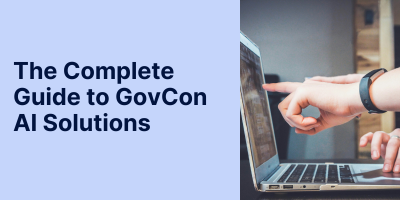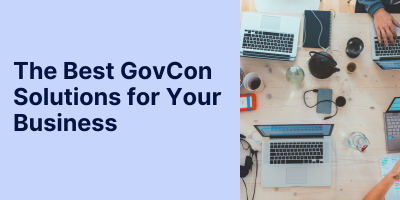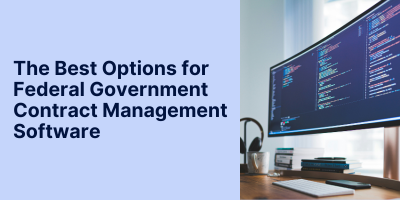GovCon in 2025: Navigating the Changing Government Contracting Landscape
Government contracting – often called GovCon – is entering a new era in 2025. Major policy shake-ups, shifting budgets, and rapid technological advances are transforming how federal contracts are won and managed. For government contractors, understanding these changes isn’t just valuable – it’s essential for survival and growth.
In this comprehensive GovCon guide, we’ll explore the latest GovCon trends, challenges, and strategies. From new regulations and heightened competition to the game-changing impact of AI, you’ll learn how to stay ahead of the curve.
By the end, you’ll see why now is the time to adapt and innovate – and how solutions like Procurement Sciences’ AI-driven GovCon platform can give you an edge. If you’re ready to thrive in the evolving GovCon arena, keep reading - and feel free to book a free demo of our AI GovCon platform to see these ideas in action!
The Evolving GovCon Landscape in 2025
The GovCon landscape is shifting beneath our feet. A series of new executive orders and laws are rewriting the rules of federal procurement. Notably, the “Restoring Common Sense to Federal Procurement” Executive Order of April 2025 is overhauling the Federal Acquisition Regulation (FAR), the 2,000-page rulebook governing contracting.
Dubbed “FAR 2.0,” this reform aims to simplify years of complex rules and cut red tape. Contractors can expect a leaner, more business-friendly FAR by October 2025, focused only on essential provisions. Agencies will also align their own procurement rules with this overhaul. (For a deeper dive into what FAR 2.0 entails and how to stay agile, see our post on Navigating FAR 2.0: Stay Agile with Awarded AI.)
Another big shift is the creation of the Department of Government Efficiency (DOGE) at the start of 2025. This new department – an initiative to boost accountability and cut waste – is already making waves across agencies. DOGE is consolidating systems, fast-tracking IT updates, and emphasizing cost-saving technologies like AI.
For GovCon professionals, this means agencies are under pressure to demand more efficiency and transparency from contractors. We’re seeing greater oversight (expect more audits and data checks) but also new opportunities for those who can deliver fast and prove value. (Our GovCon brief May 2025 DOGE Recap: What Every Contractor Needs to Know outlines DOGE’s early impacts and steps contractors should take.)
On the legislative front, massive funding shifts are underway. H.R.1 – the “One Big Beautiful Bill Act” – became law on July 4, 2025, reshaping federal priorities for the rest of the decade. This landmark bill boosts defense spending to historic levels, pours billions into border security and infrastructure, and adjusts social program funding. Defense contractors can anticipate new programs in areas like AI, cybersecurity, and sustainment, thanks to a 13% jump in the Pentagon’s budget (the first-ever trillion-dollar defense outlay).
At the same time, agencies will be scrutinizing costs – the law’s addition of over $2 trillion to the deficit means efficiency and ROI will be watchwords going forward. In practice, contractors should prepare for more competition on high-priority projects and possibly tighter margins on others. (For more details and predictions stemming from this bill, check out our Top 10 Takeaways from the One Big Beautiful Bill Act for Government Contractors.)
Amid these changes, one thing remains constant: Government contracting is huge. In FY2022 alone, the federal government spent about $694 billion on contracts, and that number is only growing in FY2025 with defense and infrastructure boosts. The pipeline is rich with opportunities – if you know where to look and how to adapt. Policy reforms like FAR 2.0 promise to streamline acquisition, but during the transition, uncertainty can be high. Changes like the removal of certain social-policy requirements (e.g. an executive order removed some affirmative action and nondiscrimination clauses in contracts) may ease paperwork for firms, yet contractors must stay vigilant to remain compliant with what rules do remain.
The bottom line: the GovCon environment in 2025 is dynamic and demanding. Those who stay informed and agile will turn upheaval into opportunity – while those clinging to “business as usual” risk being left behind. It’s a perfect time to evaluate your approach and toolset.
Need help understanding what these changes mean for you?
You can always book a free demo to see how our platform keeps you ahead of the curve.
Intensified Competition and Shrinking Budgets
If it feels like everyone is fighting over the same contract lately, you’re not imagining it. GovCon competition is fiercer than ever. Recent developments – including the reduction or even elimination of some government agencies and programs that used to fund a lot of contracts – have tightened the funding pools for contractors. In plain terms, there’s less money up for grabs in certain areas, and GovCon firms are scrambling to win a piece of a shrinking pie.
A project that might have received a dozen bids a couple years ago could see double or triple that number now. For contractors, this means you must be laser-focused in choosing the right opportunities and submit standout proposals to beat out rivals. Efficiency isn’t a luxury; it’s the deciding factor between winning and losing. As one of our experts put it, adopting the right tools and processes can be the difference between staying ahead or being left behind in today’s marketplace.
Small businesses in GovCon are feeling both pressure and protection. On one hand, large contractors are venturing into niches they previously overlooked, increasing competition for contracts of all sizes. On the other hand, small business set-asides remain a cornerstone of federal procurement strategy. By law, federal agencies aim to award at least 23% of prime contract dollars to small businesses each year (the SBA even notes this goal on its site).
Programs like 8(a), HUBZone, SDVOSB, and WOSB set-asides are still in full effect, ensuring opportunities exclusive to small firms. In fact, even as new reforms roll out, agencies are still legally required to “set aside” certain contracts for small businesses when criteria are met (the Rule of Two, for example, mandates a small-business competition if at least two qualified small firms are expected to bid).
For small GovCon players, the challenge is to capitalize on these set-asides while also differentiating themselves among peer competitors. It’s wise to keep an eye on policy tweaks (for instance, there have been proposals to broaden the Rule of Two to more contract vehicles) but also to leverage every advantage to punch above your weight.
Overall, every contractor – big or small – must do more with less. Efficient business development and capture management can make or break your year. This is driving a surge in interest for GovCon efficiency solutions.
In fact, recent industry stats show that over 20% of government contractors have already adopted AI-driven business development or proposal tools, and more than half are expected to do so by the end of the year. Why? Because when budgets tighten, being able to quickly find the right opportunities and craft winning responses with minimal wasted effort is a competitive necessity.
Investing in productivity – whether through proposal automation software, smarter bid analytics, or staff training – yields direct ROI in a crowded market. Contractors who cling to labor-intensive, old-school methods risk getting outpaced by those who streamline and innovate. Adopting an “efficiency first” mindset (and technology stack) is no longer just about saving time – it’s about staying competitive.
Our article on The Urgency of Adopting Efficiency Platforms in Government Contracting offers a closer look at how efficiency tools are becoming the secret weapon for successful GovCon teams.
As competition intensifies, ask yourself: are there better systems or tools I should be using to gain an edge? If you’re unsure, it might be time to book a free demo and discover how an AI-powered GovCon platform can help you outmaneuver your rivals.
Embracing Technology and AI in GovCon
In 2025, technology – especially artificial intelligence – is proving to be the ultimate force multiplier in GovCon. Think about the typical lifecycle of pursuing a government contract: finding relevant bids, analyzing requirements, writing proposals, ensuring compliance, and learning from past performance. Every one of these steps can be turbocharged by AI today.
For instance, manually scouring databases like SAM.gov for opportunities is often compared to finding a needle in a haystack. By the time you sift through endless postings, you might miss the perfect contract. AI-driven opportunity discovery changes that. Modern GovCon platforms use AI to scan thousands of active solicitations in seconds, automatically matching opportunities to your company’s strengths, past performance, and keywords.
This means you spend more time on bids that matter and less on fruitless searches. One contractor we know cut their bid research time from a week to just an hour by using an AI search tool – an efficiency gain that freed them up to prepare better proposals. When the right contract pops up at the right time (and you see it before others do), that’s a huge competitive advantage.
AI is also transforming how contractors understand the market. Rather than relying on guesswork or static reports, companies are using AI to track trends across procurement data. What if you knew that agency X’s spending on cybersecurity contracts jumped 40% this quarter? Or that a particular Department of Defense office is suddenly issuing lots of AI/ML research contracts?
Those insights let you pivot and focus where the money is going. AI tools can analyze historical contract data, recent awards, and even news to highlight patterns. For example, an AI market intelligence tool might reveal that the Department of Energy has significantly increased awards for renewable energy projects in a certain region – intel that could guide your business development strategy. Being armed with data-driven insights means you can anticipate what agencies want before the RFP is even out. It’s like having a crystal ball for contracting trends (one that’s fed by big data). In GovCon, knowledge truly is power, and AI delivers that knowledge in real time.
Where AI really shines is in proposal development and compliance – areas that have long been labor-intensive. Generative AI writing assistants can produce first drafts of proposal sections, answers to RFP questions, or executive summaries in a fraction of the time it takes a human alone. Of course, human expertise is still critical to refine and verify any AI-written text (we’re not at the point of letting a bot submit proposals for us, nor should we trust it to do so without oversight).
But AI can handle the heavy lifting of boilerplate text, past performance summaries, or compliance matrices, so your team can focus on strategy and customization. And speaking of compliance: missing a minor detail in an RFP can get your bid tossed out. AI tools now act as a second pair of eyes, automatically checking proposals against solicitation requirements. They can flag missing forms, formatting errors, or keywords that might indicate you overlooked a requirement. This reduces the risk of costly mistakes.
One proposal manager shared how an AI compliance checker caught a forgotten attachment before submission – a mistake that could have meant disqualification. By integrating AI as a quality control, you ensure nothing falls through the cracks while saving your team from hours of painstaking line-by-line reviews.
The proof of AI’s impact on GovCon is no longer theoretical – it’s happening on the ground. We’ve seen real stories of contractors big and small achieving more with less thanks to AI. A mid-sized firm used an AI tool to analyze their past bid feedback and discovered a pattern: they scored low on technical approach in cybersecurity projects. With that insight, they brought in a new SME and won a $5M cyber contract on the next try.
Another small business used an AI-driven pricing tool to find the sweet spot for their bid – not too high to lose, not too low to erode margins – and it helped them win multiple deals by bidding more strategically. These examples illustrate a key point: AI doesn’t replace human expertise, but it augments it in powerful ways. By taking over tedious tasks and revealing hidden insights, AI lets GovCon professionals focus on what they do best – building relationships, crafting winning strategies, and innovating solutions.
In an industry where deadlines are tight and the margin for error is slim, AI provides a much-needed boost in speed, intelligence, and accuracy. Our blog post on How AI for Government Contracting Boosts Bid Success in 2025 explores these advantages in detail, including tips on choosing the right AI tools for your needs.
Importantly, adopting AI in GovCon is not as daunting as it once was. Many platforms (like Procurement Sciences’ own AI GovCon suite) are user-friendly and designed for non-tech professionals. You don’t need a data scientist on staff to leverage predictive analytics or machine learning in your business development – the software handles that under the hood.
The key is to start small if you’re new: maybe begin with an AI tool for opportunity alerts or a chatbot that can answer common proposal questions. As you get comfortable and see ROI, you can expand into more areas. By 2025, using AI in GovCon is becoming less of a cutting-edge experiment and more of an industry best practice. In fact, not using AI might soon be viewed like not using email – technically possible, but why put yourself at such a disadvantage? Embracing these tools now will future-proof your operations.
If you’re curious what integrating AI could look like for your team, you can book a free demo of Procurement Sciences’ AI GovCon platform. We’ll show you firsthand how AI can help you find contracts faster, write better proposals, and ultimately win more in the GovCon space.
Strategies for GovCon Success in a Rapidly Changing Environment
Thriving in today’s GovCon market isn’t just about reacting to changes – it’s about proactively positioning your business for success. Here are some best practices and strategies to help you stay ahead of the competition and aligned with the new landscape:
Stay Informed and Agile
Make it a priority to continuously monitor policy updates, industry news, and agency forecasts. Subscribe to GovCon news outlets or alerts so you know about shifts like new Executive Orders or agency reorgs as soon as they happen. When you hear about something like FAR 2.0 or the latest funding bill, convene your team to discuss potential impacts on your pipeline. Agile contractors often re-evaluate their capture strategies quarterly (if not monthly) in light of the latest intel.
If, for example, a White House memo indicates a pivot to commercial-off-the-shelf solutions, be ready to highlight any commercial products you offer in upcoming bids. Knowledge is power – and in GovCon, the winners are often those who adapt first.
(Pro tip: Leverage tools or an internal “intel brief” process – similar to our AI-driven GovCon Executive Intel Briefs – to digest what changes like DOGE mean for your contracts.)
Focus on Your Strengths (and Find Your Niche)
The most successful GovCon firms have a clear identity and value proposition. Figure out what you do best – maybe it’s deep expertise in cybersecurity, or a track record of low-cost logistics, or innovative AI solutions for data analysis – and double down on it. In a market with hundreds of bidders, specialization can set you apart.
Also consider the flip side: know which opportunities not to chase. Pursuing every RFP that comes along is a recipe for wasted effort. Use data to identify contracts where you have a higher probability of win (due to past performance, customer knowledge, etc.). Many contractors are now creating bid/no-bid checklists that incorporate lessons learned. If an opportunity doesn’t check enough boxes, it’s okay to skip it and focus on more promising ones.
This kind of discipline is easier if you use tools (or spreadsheets at minimum) to track and score opportunities against your strengths. And when you find that niche where you shine, build your brand around it – become known as “the go-to small business for AI-driven training simulators” or “the mid-tier firm that always delivers on time for Army IT contracts,” for example. Reputation goes a long way in GovCon.
Invest in Relationships and Networking
Despite all the technology, GovCon is still a people business. Engage with agency officials, industry peers, and partners regularly. Attend government industry days, join GovCon associations, or participate in webinars and events (many are virtual, making them easier to attend). Building a network can tip you off to upcoming opportunities before they hit SAM.gov, or alert you to changes in agency priorities.
Moreover, partnerships are powerful – consider teaming up with complementary businesses on joint bids. If you’re a small business, teaming with a larger prime (or vice versa) can open doors to contracts neither of you could win alone. Just be sure any partnership clearly defines roles and leverages each party’s strengths. And don’t overlook the value of subcontracting; it can be a foot in the door that leads to prime contracts later. In 2025’s fast-evolving environment, a strong network can act as an early warning system and an opportunity generator. Make relationship-building a continuous part of your strategy.
Leverage Data and Metrics
As oversight increases and budgets face scrutiny, agencies want proof of performance and ROI. Contractors that can clearly quantify their value will stand out. This means tracking your own performance metrics and having data-driven success stories ready to share. Did your solution help an agency save 15% on costs or cut delivery time by 2 months? Make sure you capture that and include it in proposals. Use dashboards or spreadsheets to monitor things like on-time delivery rate, customer satisfaction scores, win rates on proposals, etc.
Internally, data can help you improve too – analyze which proposals you lost and why, which areas you consistently score lower on, and address them. We also recommend keeping an eye on procurement data that’s publicly available: who’s winning what, and at what price. There are tools (and our platform is one of them) that aggregate award data so you can gauge where you stand against competitors. In short, treat data as a strategic asset. Those insights will both impress your clients and guide your internal decisions.
Embrace Efficiency Tools and Training
As we’ve emphasized, efficiency is the name of the game in GovCon 2025. Ensure your team is equipped with modern tools – whether it’s a proposal management software, an AI writing assistant, or a CRM tailored for federal sales. Equally important is training: invest in upskilling your workforce to use these tools effectively and to stay current with best practices (like understanding the nuances of the latest FAR clauses or how to navigate the new SAM.gov interface). Many companies are adopting a “center of excellence” approach where a small team becomes the guru on a new tool or process, then trains others.
Also, consider obtaining relevant certifications (for both your company and your staff) – things like CMMC compliance, ISO quality certifications, or professional certifications (e.g. PMP, APMP for proposal managers) can both improve your operations and make your proposals more credible. Remember, an efficient and knowledgeable team will be more agile and capable of handling whatever twists and turns the GovCon road ahead may bring.
Above all, remain customer-focused. With all the talk of policy and technology, success still hinges on understanding an agency’s mission and pain points. Keep the agency’s goals front and center in every proposal and interaction. Agencies are more likely to award contracts to contractors who get what they’re trying to achieve and show genuine commitment to helping them succeed (not just checking the boxes in the RFP). If you combine that customer-centric approach with the right tech and an adaptive mindset, you’ll be well positioned to prosper.
Implementing these strategies might sound like a lot of work – and it is – but you don’t have to do it alone. This is exactly where platforms like Procurement Sciences’ AI GovCon solution come in, acting as a force multiplier for your efforts. Our platform was built by seasoned GovCon professionals who anticipated these industry shifts. It’s designed to help you stay informed, work efficiently, and make data-driven decisions at every step of the contracting process.
Whether it’s generating a quick compliance matrix for a proposal or flagging a must-know trend in your market, the right tool can save you countless hours and headaches. Many of the best practices above are baked into our solution’s DNA (and can be customized to your workflows). If you’re curious how leveraging such a platform could look for your team, don’t hesitate to book a free demo. It’s an easy way to see tangible examples of these strategies supercharged by AI and smart design, helping you transform advice into action.
Conclusion: Adapt, Innovate, and Win in GovCon
The GovCon world is changing at a pace we haven’t seen in a long time. From sweeping regulatory reforms to new government priorities and technological disruption, 2025 is a year of inflection for government contractors. But with great change comes great opportunity. Contractors who adapt and innovate will find that they can not only weather the turbulence – they can thrive and grow.
The keys to success in this environment are clear: stay informed about the shifting landscape, embrace efficiency and technology to work smarter, and keep a laser focus on delivering value to government customers. Use AI and data to gain insights that your competitors miss. Sharpen your processes so you can respond to opportunities faster and with winning precision. And never lose sight of the mission needs at the core of every RFP – if you consistently show that you solve real problems and offer true partnership to your agency clients, you will stand out in any crowd.
GovCon has always been competitive, but today it’s also collaborative in new ways – humans and AI collaborating, small businesses and large primes teaming up, industry and government communicating more openly about how to achieve better outcomes. It’s an exciting time to be in this field if you’re willing to push the envelope. The contractors who combine the timeless fundamentals (like good client relationships and quality delivery) with modern tools and agile thinking are writing the next chapter of GovCon success stories right now.
As you plan your moves in this evolving arena, remember that you don’t have to go it alone. Procurement Sciences is here to support the GovCon community with cutting-edge solutions and expertise. We’ve helped companies just like yours transform how they pursue and win contracts – and we’re passionate about driving the human–AI collaboration that unlocks reliable, repeatable success. The future of GovCon will be defined by those who innovate and adapt. Will you be one of them?
If you’re ready to elevate your GovCon game and see firsthand how innovation can translate into more wins, take the next step. It’s time to invest in your growth and resilience. It’s time to book a free demo of our AI GovCon platform.
Let us show you how to save time, deliver faster, and win more in this new era of government contracting. Here’s to your GovCon success in 2025 and beyond!


%20(1)%20(1).png?width=1440&height=711&name=PSciAI-Save-time.-Deliver-faster.-Win-More-(Black)%20(1)%20(1).png)
-2.png)



%20(1200%20x%20600%20px).png)
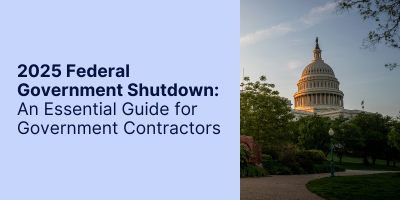
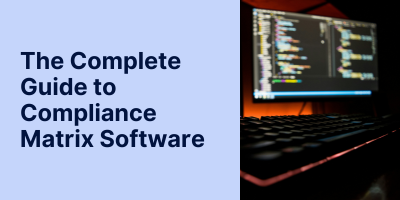



-2.png)
-2.png)
